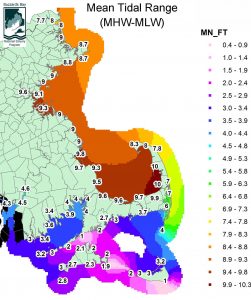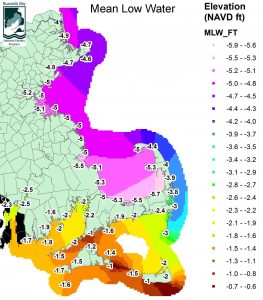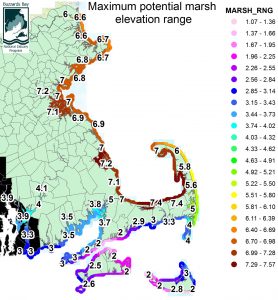by Joe Costa. Posted June 12, 2017; last revised July 6, 2017.
Subpages: Tidal Datum Viewer | Salt Marsh Lower Boundary Elevation
Related pages: Interactive map of marsh monitoring sites | Migrating salt marshes | Tidal Elevations and Datums in Buzzards Bay | Tidal Datums and the HTL | Tidal Datums | Salt Marsh Expansion with SLR | Atlas of Tidally Restricted Salt Marshes | Tidal Datum Viewer | Salt Marsh Lower Boundary Elevation | Interactive map of marsh monitoring sites | Migrating salt marshes | Tidal Elevations and Datums in Buzzards Bay |
On our subdomain climate.buzzardsbay.org, in 2013 we posted a number of webpages that discuss and explain geodetic and tidal datums, and their use in environmental regulations, the high tide line (defined by “king tides“), the location of salt marshes within those tidal zones, site specific tidal elevations in Buzzards Bay, and information about how to use online tools like VDatum to help review site plans and permit applications. On this page, we consolidate that information in a simpler form, and expand the maps to show mean high water, mean low water, the estimated high tide line, and other tidal elevations of interest, for the entire coast of Massachusetts. You can view tidal datums for any coastal location in Massachusetts on our interactive tidal datum viewer page. The maps on this page, and data in the interactive viewer, were prepared in ArcGIS using a coordinate and elevation data matrix developed with NOAA’s VDatum software tool using the GEOID12B.
Geodetic Vertical Datum Basics
Geodetic vertical datums are the zero reference points or reference elevations from which we measure orthometric elevations. In common use, they are thought of as the reference elevation to which we measure above “sea level,” although they do not typically coincide with the actual local mean sea level for a particular location because of variations in gravity and water levels across the earth. In maps and site plans used in the United States, the two most common geodetic vertical datums used are the National Geodetic Vertical Datum of 1929 (NGVD 29) and North American Vertical Datum of 1988 (NAVD 88). The elevations reported on the tidal datum maps at the bottom of this page are in feet NAVD 88. This NAVD 88 datum is the reference elevation used in FEMA flood insurance rate maps, and by most federal and state agencies today. It is about 10 inches higher than the NGVD 29 datum in Buzzards Bay, and 4 to 6 inches above local mean sea level in Massachusetts. Orthometric heights are also corrected for the “geoid” model, and this adjustment is important when comparing different LiDAR data sets.
Tidal Datum Basics
In our area we have mixed semi-diurnal tides. These are slightly asymmetrical high and low tides that occur twice over a 24 hour 50 minute period. Consequently, on most days we have two high tides and two low tides. One of these low tides is lower than the other, and one of the high tides is higher than the other. These two tides are described as the “lower low” tide and the “higher high” tide respectively. The heights of these semi-diurnal tides change over the course of the month because of the relative alignment of the moon and sun which both exert gravity on the oceans to create the tides. When the moon and sun are aligned (new moons and full moons), the higher highs are higher and the lower lows are lower, and these are referred to as “spring tides.” New moon spring tides are more extreme than full moon spring tides. These occur every two weeks. The midpoint between spring tides (also every two weeks), are called “neap tides”, which are the periods of the smallest tide ranges.
Tidal datums are 19-year averages of all tides in an area. The zero value of the datum is the average of the Mean Lower Low Water (MLLW) heights over the 19-year period called a tidal epoch. The values of the Local Mean Sea Level (LMSL), as well as Mean Low Water (MLW), Mean High Water (MHW), and Mean Higher High Water MHHW are the average of each of these terms for the 19 year epoch, relative to the MLLW average. Every 25 years or so, the federal government revises these tidal datums by examining new “epochs” of data to account for relative sea level rise. “Mean Tide level” (MTL) is just the mean of the MHW and MLW values, although it is generally very close in value to LMSL. Sometimes these elevations are reported to the “station datum,” which is the zero elevation of the tide gauge staff. In Fig. 1, neap and springs tides are compared to tidal datum elevations for Round Hill Point, Dartmouth. Tides for any sites can be plotted at the NOAA Tides and Currents page.

Fig. 1. Predicted tidal cycle (from NOAA) showing neap and spring tides over two weeks during May 2017 for Round Hill Point, Dartmouth, MA, compared to tidal datum elevations for the site. MHWN = mean high water neap. Click to enlarge.
Salt Marsh Vegetation Elevations
Salt marshes are generally divided into two habitat types that are defined by tidal inundation and species composition: the low marsh and the high marsh. The low marsh is dominated by smooth cordgrass, Spartina alterniflora. In scientific and technical publications, the low marsh is typically defined as beginning at the local mean sea level (LMSL) elevation, but occasionally it is given the tidal elevation “mean high water at neap tide” (MHWN). The actual elevation that the low marsh begins varies depending on numerous physical and biological factors within an estuary, but seems to generally range between LMSL to a foot to three above that height depending on the tidal range and various physical and biological factors. On our salt marsh lower boundary elevation page, we show the LiDAR elevations of low marsh boundary at selected sites in Massachusetts.
The low marsh continues to about the mean high water (MHW) line, which generally defines its upper boundary. The high marsh is dominated by salt meadow cordgrass Spartina patens. This species typically begins to be the dominant plant species at the mean high water (MHW) elevation. The high marsh continues grading into other species, to the high tide line (HTL, now popularly referred to as the King Tide), which is the regulatory boundary definition of salt marshes in Massachusetts. The upper marsh boundary consists of a transition zone grading into upland or freshwater wetland species, and the actual boundary may be defined by vegetation and salinity, rather than elevation, as established in Massachusetts case law.
Important Regulatory Tidal Datums
In Massachusetts, tidal wetlands permits issued pursuant to Chapter 91 of Massachusetts General Law, are required for fill and construction for projects between the mean high water (MHW) and mean low water (MLW) lines (Figs. 2 and 3). The legal definition of these boundaries, legal cases about the zone, and the rights of the public to use this zone for fishing, fowling, and navigation are discussed at this Massachusetts Law Library beach rights info page. The “high tide line” (defined as the highest tide of the year) establishes the legal boundary for salt marshes in the state’s Wetland Protection Act, and is the boundary for federal Navigable Waters where there are no bordering vegetated wetlands. While the high tide line (together with biological indicators) establishes the regulatory boundary of salt marshes. The two figures below summarize both regulatory boundaries and salt marsh habitat types relative to tidal and geodetic datums.
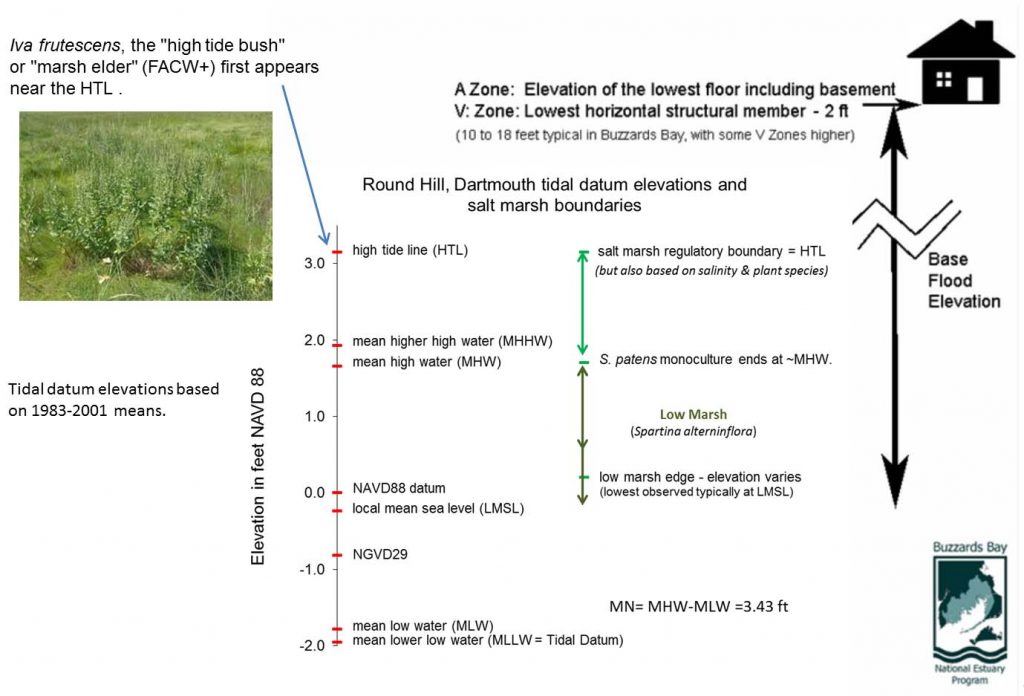
Fig. 2. The relationship between tidal datums, land elevation datums, and salt marshes in Buzzards Bay. (click to enlarge)
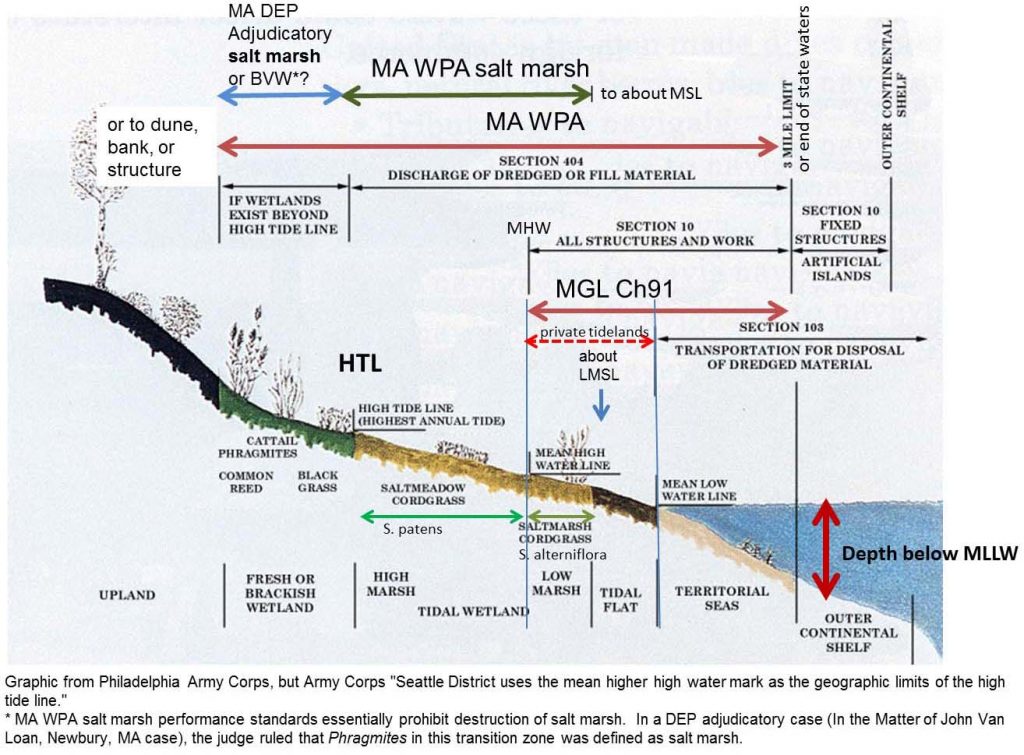
Fig. 3. Tidal datums, salt marsh boundaries, and coastal wetlands and their regulation under state and federal laws. HTL = high tide line, MHW = mean high water, MA WPA Massachusetts Wetlands Protection Act. (click to enlarge)
Calculating the High Tide Line for Massachusetts
VDatum does not calculate the high tide line (HTL), which is the highest predicted tide of the year. As per Fig. 4, the HTL of 2016 was roughly equal to the highest astronomical tide (HAT, the highest predicted tide during the last tidal epoch, 1983-2001) for nearly all stations in Massachusetts examined. This happened to be the case because the moon had one of its closest orbital approaches to the earth in many decades, although in practical terms, the highest tide of any given year varies in a range of only a few inches in Buzzards Bay and the south side of Cape Cod. This finding also means HAT elevations reported by NOAA are also an excellent estimate of the HTL.
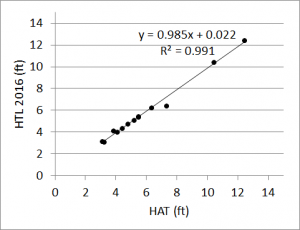
Fig. 4. The predicted highest tide of 2016 (the high tide line) versus the highest astronomical tide for the last tidal epoch. The equation is for the datum MLLW=0.
However, HAT values are reported for only a few tidal stations in Massachusetts. Is there a way to estimate the HTL for any portion of the coast or within embayments? In reviewing the tidal records for the 2016 HTL for all stations in Massachusetts, the HTL elevation for 2016 correlated very well with both the MHW line and MHHW line elevations (relative to MLLW) for all stations (Fig. 5). This finding means that a reasonable estimate of the HTL can be calculated from the regression curve in Fig 5, using the formula (MHW-MLLW)*1.183+0.756 + MLLW = HTL (the MLLW adjustment converts the elevation NAVD 88, like the other data on the interactive map).
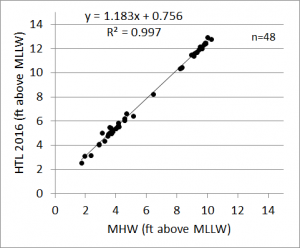
Fig. 5. The predicted highest tide of 2016 (the high tide line) versus the mean high water elevation relative to the tidal datum. The equation is for the datum MLLW=0.
A Note about Nautical Charts and Topographic Maps
The shoreline on nautical charts is mean high water (MHW), except for areas of salt marsh, where the apparent shoreline is shown (Fig. 6). Because the lowest limit of salt marshes is local mean sea level (LMSL), or somewhat above that, the vegetated shoreline elevation on a nautical chart is generally between LMSL and mean high water neap (MHWN). Around Buzzards Bay, MHW is mostly near 2.5 ft NGVD 29 or 1.6 ft NAVD 88 (+/- 0.2 ft). LMSL is mostly around -0.4 ft NAVD 88 in Buzzards Bay. The maps below show the actual elevations in and around Buzzards Bay and the rest of the state, and you can, of course, use the tidal datum viewer to find the exact elevations for your site.
In contrast to land elevations on nautical charts which are tied to a geodetic datum, the bathymetric depths are defined relative to the tidal datum. Before 1990, the tidal datum on nautical charts (and used for other NOAA calculations) was set to MLW; after 1990, it was set to MLLW. This is only a 4-inch difference in most of Massachusetts.
This difference in datums between land elevation and bathymetry means a bathymetric depth of -1 foot is at a land elevation of about -3 feet in NAVD 88 in Buzzards Bay, and this elevation difference is greater north of Cape Cod. Land elevations on maps produced by the federal government before 1991 are NGVD 29 (which is a 9 inches to foot below NAVD 88 in Massachusetts, so land elevations on earlier maps are nearly a foot higher). After 1991, most maps produced by the federal government are typically referenced to the NAVD 88 datum.
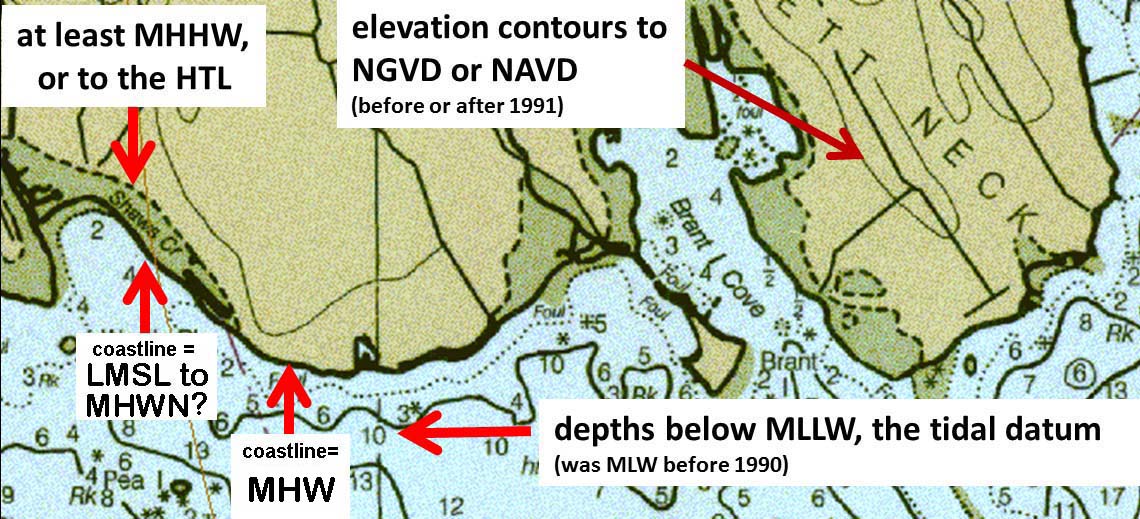
Fig. 6. Tidal datums associated with shoreline boundaries, land elevations, and bathymetric depths as shown on nautical charts.
Essential Definitions and Concepts
“Marks” vs. “Lines”: NOAA’s Center for Operational Oceanographic Products and Services, and others, make a distinction between these terms. A tidal datum line on a chart or map represents the intersection of the land with the calculated tidal datum elevation. A mark is the physical or biological indicators of recent tides and wave run-up (e.g., a line of shells or wrack observed at the “high water mark”). You can also observe the high water mark for a particular day. The observed high water mark may not equal to either the mean high water or mean higher high water lines. (see https://shoreline.noaa.gov/glossary.html )
However, in common use, as well as in Massachusetts state laws and regulations, these two terms are used interchangeably with the same meaning. Chapter 91 exclusively uses the word mark, and the Chapter 91 regulations (310 CMR 09) says the “high water mark” is equal to the “mean high tide line.” Case law has also tied Chapter 91 marks to the NOAA tidal datum elevations.
High tide line (HTL): In certain regulations, this the line on a map that represents the elevation of the highest tide of the year (the so-called King Tide), which is well above mean high water line. It is now the jurisdictional limit of federal navigable waters and certain federal permits (and may be expanded by bordering vegetated wetlands). It also defines the upper boundary of salt marshes under the Massachusetts Wetlands Protection Act (the “highest high tide line, that is, the highest spring tide of the year”; 310 CMR 10.32).
Mean high water (MHW) [line]: The 19-yr tidal epoch average of all high tides, and the line on a map that represents that elevation. It is the jurisdictional limit of Massachusetts Chapter 91 tidelands, and is the approximate boundary elevation between the “high marsh” and the “low marsh.” It is also the coastline boundary on nautical charts and topographic maps (except for salt marshes, where the “apparent” coastline of the low marsh is shown). Called variously the “high water mark,” “mean high water mark,” “mean high tide line,” and “mean high water shoreline” in the Massachusetts General Law Chapter 91 law and regulations.
Massachusetts Private Tidelands: the area between mean high water (MHW) and mean low water (MLW).
Intertidal Zone: Extends above MHW and below MLW. Generally extends from MLLW to at least MHHW, so is greater in area than Commonwealth private tidelands.
Mean higher high water (MHHW) [line]: The 19-year tidal epoch average of the higher of the two daily high tides. It is often (but not always) used to define the top of the “intertidal” zone. It is located between mean high water line and the high tide line.
Mean Lower Low Water (MLLW): The 19-year tidal epoch average of the lower of the two daily low tides. Charts since the 1990s nautical show depths below MLLW (zero elevation datum). Some town bylaws still require depths reported to below MLW, the earlier convention.
Useful Links
2014 GPS on Bench Marks Campaign: https://www.ngs.noaa.gov/heightmod/2014GPSonBM.shtml (Reports geoid accuracy for Massachusetts)
OPUS: Online Positioning User Service: https://www.ngs.noaa.gov/OPUS/view.jsp (crowd sourced by engineers; GPS elevation data for benchmarks in each state)
NOAA Tide Predictions Page: https://tidesandcurrents.noaa.gov/tide_predictions.html
Look up tidal datums at benchmarks: https://www.ngs.noaa.gov/Tidal_Elevation/
Online VERTCON Calculator (NGVD 29 to NAVD 88): https://geodesy.noaa.gov/NCAT/ (just for geodetic elevation conversion; enter decimal Lat and Long. Longitude should be entered without a sign, and with a leading zero for values under 100 degrees west. For example, 70.1234 degrees west should be entered as 070.1234)
VDatum online tool: https://vdatum.noaa.gov/vdatumweb/ (70.1234 degrees west is entered as -70.1234)
Mass DOT has a great Massachusetts benchmark information website: https://gis.massdot.state.ma.us/geodeticcontrol/
View NOAA tidal station datasheets at: https://www.ngs.noaa.gov/datasheets/
NOAA shoreline terminology definitions: https://shoreline.noaa.gov/glossary.html
NOAA data viewer: https://coast.noaa.gov/dataviewer/#/lidar/search/ (zoom to area you want, draw search box, select coverage)
State-wide maps
Click on one of these maps to view a larger version, or use our tidal datum interactive viewer for elevations near a specific site of interest.
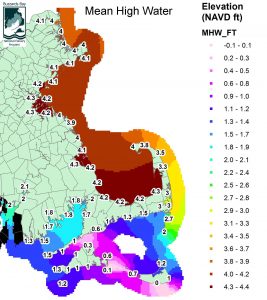
Mean high water (MHW) elevations around Massachusetts. Elevations are in feet above the “NAVD 88” reference datum.
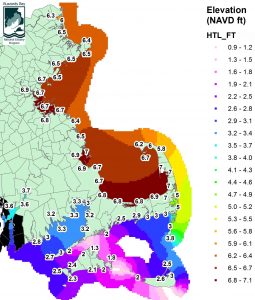
Estimated high tide line (HTL) elevations around Massachusetts. The HTL is the highest tide of the year, and is sometimes called the “King Tide.” The HTL elevations shown are very close to the highest astronomical tide (HAT) reported for the current tidal epoch (NTDE 1983-2001). Elevations are in feet above the “NAVD 88” reference datum.
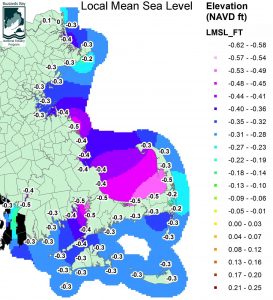
Local mean sea level (LMSL) elevations around Massachusetts. Elevations are in feet above or below the “NAVD 88” reference datum. LMSL is generally the lowest elevation that a marsh will be observed. The actual lower boundary of a marsh may exist up to 1 to 3 feet above LMSL depending upon the tidal range as described on our low marsh boundary page.
